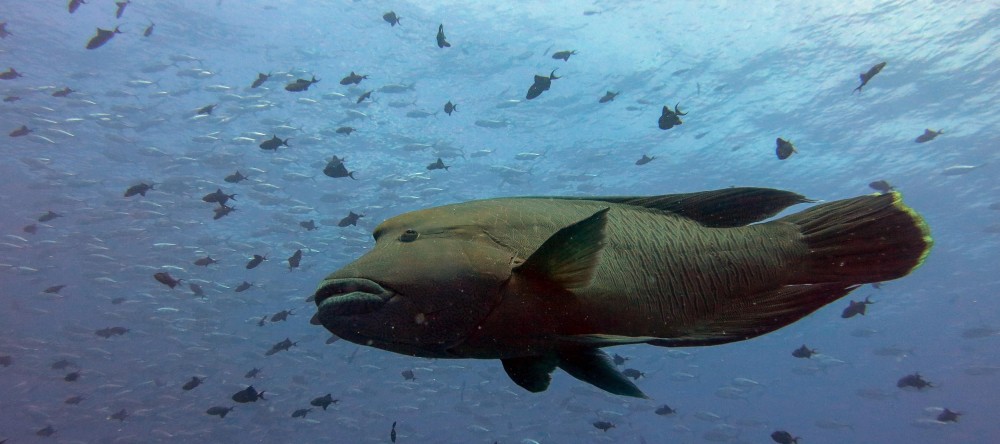- Research
New study indicates maml populations in Palau are in decline
Researchers from the Palau International Coral Reef Center (PICRC), Pristine Seas, National Geographic Society, and the University of Hawaiʿi have conducted comprehensive stock assessments of the local populations of kemedukl (bumphead parrotfish) and maml (Napoleon wrasse). The results, published in the scientific journal, Aquatic Conservation: Marine and Freshwater Ecosystems, recommend that the fisheries for both species remain closed until stocks recover.
Kemedukl and maml are two of the largest fish species that inhabit our coral reefs. They are important components of the ecosystem and are held in high esteem by the dive tourism industry. Harvested for centuries by local fishermen, they have high economic and cultural value. However, intensive fishing in the 1990s saw their populations plummet. To prevent them disappearing all together, legislation was enacted in 2006 that banned the extraction, possession, and sale of both species.
In 2013 and 2021, researchers surveyed 90 sites for kemedukl and maml across Palau, from Kayangel down to Angaur, covering over 1,000 hectares of reef. The results of the study found that the number of kemedukl has increased slightly over the past eight years but not to the point where limited fishing could be recommended. However, the number of maml has continued to decline, likely due to illegal poaching.
“I was hoping that the populations of kemedukl and maml would improve in 2021, compared to 2013. The good news is we saw a slight increase in the kemedukl population but what is very alarming is that the maml population has gone in the opposite direction and is very low” said PICRC’s Chief Executive Officer, Dr. Yimnang Golbuu. “The results of this study suggest that there is significant poaching, preventing the full recovery of kemedukl and maml.”
The study also found that divers would pay $1.27 million more per year for strictly managed catches of both species, and nearly $3.00 million more per year if the fisheries remain closed. This far exceeds the total market value of kemedukl and maml combined and shows that healthy marine ecosystems are valued by both locals and tourists alike and are essential for the post-COVID-19 economic recovery of Palau.
“These charismatic species are some of the largest fishes that inhabit coral reefs, and their economic, cultural, and ecological value can’t be overstated,” said lead author of the study, Dr. Alan Friedlander from University of Hawaiʿi. “Education, outreach, and enforcement are urgently needed to ensure the current fishery closure is effective in recovering the population and meeting the public’s management target so the fishery can one day be opened for sustainably customary harvest.”
Scientific paper
- Title: Assessing and managing charismatic marine megafauna in Palau: Bumphead parrotfish (Bolbometopon muricatum) and Napoleon wrasse (Cheilinus undulatus)
- Journal: Aquatic Conservation: Marine and Freshwater Ecosystems
- Authors: Alan M. Friedlander, Asap Bukurrou, Alex Filous, Christina Muller Karanassos, Haruko Koike, Shirley Koshiba, Geory Mereb, Victor Nestor, Kirsten L. L. Oleson, Dawnette Olsudong, Jay Oruetamor, E. Ikelau Otto, Kevin Polloi, Geraldine Rengiil, Elsei Tellei, Yimnang Golbuu
- Date of publishing: 26 February 2023 https://doi.org/10.1002/aqc.3929


